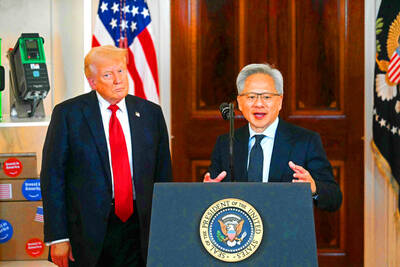Hon Hai Precision Industry Co (鴻海精密) felt the squeeze from last year’s delayed launch of Apple Inc’s iPhone X, the latest results from the world’s largest electronics contract manufacturer show.
Were it not for a one-time gain of US$2.2 billion from the sale of Sharp shares, it would have been the company’s worst holiday quarter since 2010, analysts said.
Hon Hai on Friday last week reported net income of NT$71.7 billion (US$2.5 billion) in the three months that ended on December last year, based on calculations using previously reported earnings. That exceeded the NT$58 billion average estimate of analysts. Fourth-quarter revenue reached an all-time high of NT$1.73 trillion. Earnings per share (EPS) were NT$4.14.
Analysts point to Hon Hai’s December sale of ¥352.5 billion (US$3.32 billion) of Sharp shares to ES Platform LP, a partnership formed by company employees, as the main reason for the iPhone maker’s better-than-expected results.
“The main profit gains came from the non-operating end. Hon Hai disposed of Sharp’s special shares in the same period, recognizing up to NT$66 billion,” Fubon Securities Co (富邦證券) analyst Arthur Liao (廖顯毅) said in a note. “Without this, EPS in the quarter would only be around NT$1.44.”
EPS would have been about NT$1.28 without the gain from the Sharp sale, Vincent Chen (陳豊丰), regional head of research at Yuanta Securities Investment Consulting Co (元大投顧), said in a note.
Based on the analysts’ calculations, Hon Hai’s fourth-quarter net income would have been less than NT$25 billion without the sale of Sharp shares. That would have been the company’s lowest fourth-quarter figure in seven years.
Bloomberg calculated that operating profit was NT$32.4 billion. The gross margin and the operating profit margin missed estimates.
Hon Hai shares fell 3.17 percent to close at NT$88.50 on Saturday, with 136.29 million shares changing hands, while the TAIEX ended up 0.12 percent at 10,919.49 points.
Full-year net income was NT$138.7 billion, falling for the first time since 2008, as profits took a hit in the second half of last year, partly on delayed iPhone X shipments.
Despite reports of lackluster demand for the device, Apple chief executive officer Tim Cook said on an earnings call in February that the iPhone X was the best-selling smartphone over the holidays, citing research firm Canalys.
Hon Hai is the sole maker of Apple’s priciest gadget.
The company gets more than half of its revenue from Apple, but chairman Terry Gou (郭台銘) is looking for ways to expand beyond merely assembling gadgets — especially as the smartphone market sputters.
He is taking Foxconn Industrial Internet Co (FII, 富士康工業互聯網), a subsidiary focused on cloud services and “smart” manufacturing, public in China.
In a March 13 note, Liao estimated FII’s market value could hit 269 billion yuan (US$42.79 billion) compared with Hon Hai’s US$56 billion.
Hon Hai does not provide revenue breakdowns, forecasts or hold investor conferences.
A Foxconn spokesman did not provide details on the sale of Sharp shares.

Taiwan Semiconductor Manufacturing Co (TSMC, 台積電) last week recorded an increase in the number of shareholders to the highest in almost eight months, despite its share price falling 3.38 percent from the previous week, Taiwan Stock Exchange data released on Saturday showed. As of Friday, TSMC had 1.88 million shareholders, the most since the week of April 25 and an increase of 31,870 from the previous week, the data showed. The number of shareholders jumped despite a drop of NT$50 (US$1.59), or 3.38 percent, in TSMC’s share price from a week earlier to NT$1,430, as investors took profits from their earlier gains

AI TALENT: No financial details were released about the deal, in which top Groq executives, including its CEO, would join Nvidia to help advance the technology Nvidia Corp has agreed to a licensing deal with artificial intelligence (AI) start-up Groq, furthering its investments in companies connected to the AI boom and gaining the right to add a new type of technology to its products. The world’s largest publicly traded company has paid for the right to use Groq’s technology and is to integrate its chip design into future products. Some of the start-up’s executives are leaving to join Nvidia to help with that effort, the companies said. Groq would continue as an independent company with a new chief executive, it said on Wednesday in a post on its Web

CHINA RIVAL: The chips are positioned to compete with Nvidia’s Hopper and Blackwell products and would enable clusters connecting more than 100,000 chips Moore Threads Technology Co (摩爾線程) introduced a new generation of chips aimed at reducing artificial intelligence (AI) developers’ dependence on Nvidia Corp’s hardware, just weeks after pulling off one of the most successful Chinese initial public offerings (IPOs) in years. “These products will significantly enhance world-class computing speed and capabilities that all developers aspire to,” Moore Threads CEO Zhang Jianzhong (張建中), a former Nvidia executive, said on Saturday at a company event in Beijing. “We hope they can meet the needs of more developers in China so that you no longer need to wait for advanced foreign products.” Chinese chipmakers are in

POLICY REVERSAL: The decision to allow sales of Nvidia’s H200 chips to China came after years of tightening controls and has drawn objections among some Republicans US House Republicans are calling for arms-sale-style congressional oversight of artificial intelligence (AI) chip exports as US President Donald Trump’s administration moves to approve licenses for Nvidia Corp to ship its H200 processor to China. US Representative Brian Mast, the Republican chairman of the US House Committee on Foreign Affairs, which oversees export controls, on Friday introduced a bill dubbed the AI Overwatch Act that would require the US Congress to be notified of AI chips sales to adversaries. Any processors equal to or higher in capabilities than Nvidia’s H20 would be subject to oversight, the draft bill says. Lawmakers would have